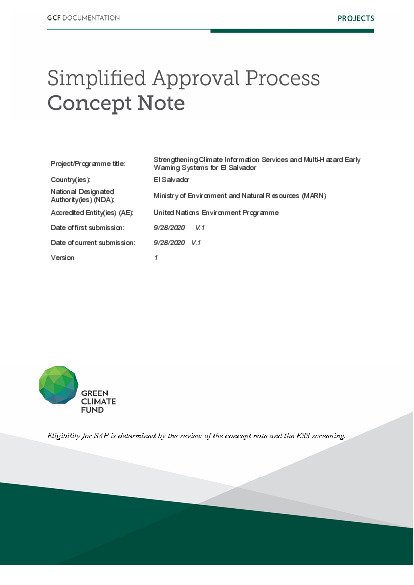Strengthening Climate Information Services and Multi-Hazard Early Warning Systems for El Salvador

Strengthening Climate Information Services and Multi-Hazard Early Warning Systems for El Salvador
El Salvador's social and economic conditions make the country vulnerable to the risks associated with climate variability and climate change. Over the last decade the annual meteo-hydrological regime has registered a significant variation, especially in terms of frequency and distribution of precipitation events. Several climate projected scenarios highlight an increase in the annual average temperature of 2 or 3 degrees Celsius in the next six decades creating the conditions for extended periods of severe droughts, which are already affecting the country.[1]
The most significant source of climatic variability in El Salvador are the El Niño-Southern Oscillation (ENSO) along with the opposite side of the fluctuation, i.e. La Nina. In addition, the country lies in the path of both Atlantic and Pacific tropical storms, whose frequency and impacts have registered a clear raise in recent decades. The Pacific coastline is also subject to sea level rise and it is expected that 10-28% of the country´s coastal zone will be lost by the end of the century. In general, 30% of the population is highly vulnerable to sea level rise and other climate change impacts as they are located in coastal areas.[2] Furthermore, emerging infectious diseases including zoonoses, such as the COVID-19, have increased the vulnerability of the country, and raised pressure towards important institutions; El Salvador may have to confront a major climaterelated disaster at a time when they are firmly focused on COVID-19 response and recovery.
The project will provide El Salvador with a consistent framework for the sustained production and use of Climate Information Services, including enhanced data capacity and institutional arrangements, impact-based forecasts, and a nation-wide Multi Hazard Early Warning System (MHEWS). The project will support the achievement of a paradigm shift where the use of science-based climate information supports resilient development pathways, optimizing the use of resources, and encourage domestic and foreign investment. Standardized climate risk assessment methodologies and systematic climate risk information services will be adopted and produced to enable the implementation of nation-wide risk reduction policies and reduce the risks of the most vulnerable communities. Information will move from weather predictions to a more accurate identification of potential social, economic and environmental impacts and the urgent activities to be implemented.
The project has the ambition to improve the overall management of climate risk in El Salvador, including by enhancing preparedness and resilience of up to 4.6 million Salvadorians (81.5% of total population) currently exposed to the risk of climate-related extreme events and hazards[3] such as floods, mudflows and droughts.
A National Framework for Climate Services (NFCS) will be designed and implemented to facilitate the delivery of best practice climate services across the country. The project will provide accurate information and capacities to contribute in the substantial reduction of El Salvador's exposure and vulnerability to climate risks and losses in lives, livelihoods and health and in the economic, physical, social, cultural and environmental assets of persons, businesses, through pilot community-based interventions. The outcomes expected from its implementation are as follows:
National Climate Services and Multi-Hazard Early Warning Systems supported by institutions, coordination platforms, legislation and financial mechanisms;
Enhanced Climate Information and Data;
Strengthened response, adaptive capacity and reduced exposure to climate risk;
Improved use of climate information for investment planning in different sectors.
At the request of the GCF Nationally Designated Authority (NDA) of El Salvador, UN Environment Programme (UNEP) will serve as the Accredited Entity for the project. The AE will work with a range of partners and executing entities, including, regional organizations such as SICA and CEPREDENAC as mentioned above, the regional Offices of United Nations Office for Disaster Risks Reduction (UNDRR) and World Meteorological Organization (WMO) to make the necessary arrangements for the implementation of the project.
[1] Third National Communication to the Conference of the Parties under the United Nations Framework Convention on Climate Change, El Salvador 2018
https://unfccc.int/sites/default/files/resource/TCN%202018%20REjecutivo%...
[2] El Salvador Climate Change Risk Profile Fact sheet 2017 (USAID):
https://www.climatelinks.org/sites/default/files/asset/document/2017_USA...
[3] Informe nacional del Estado de los Riesgos y Vulnerabilidades (INERV), Demografía. Proyecciones de población 2016 del Censo Nacional de Población y Vivienda 2007.